Sorry if I repeat myself here. I typed for over two hours, then had to turn my 'puter off because the anti-virus was slowing it down to a painful crawl. I lost everything and had to start over, but I'm calm now.
First verify we're talking about the same thing. I taught Automotive Brakes for many years but I never heard the terminology "leading and trailing" used for anything other than the front and rear shoes on a drum brake. If you're referring to something else, please set me straight. Every manufacturer used the duo-servo drum brake as far back as at least the 1950s which was before my time. They are inexpensive to build and very efficient so it was only natural to keep on using them on the rear. Disc brakes are used on the front where they do most of the stopping because they are much less prone to various forms of brake fade.
The leading / trailing shoe issue has nothing directly to do with the location of the star wheel adjuster. The duo-servo brake gets its efficiency from the front shoe acting on the rear one to help apply it. That requires a movable link on the bottom between the two shoes, and it was convenient to incorporate the adjuster into that link. The adjuster can also be placed up near the tops of the shoes but that would increase the cost and the number of parts. The exception would be if the vehicle was lightweight and didn't need as much rear braking power. A non-servo brake with a fixed lower anchor could be used, and that would require the adjuster to be placed somewhere else.
Some of the first cars I saw with non-servo brakes were the Chrysler K-cars and the Omni / Horizon.S. A duo-servo brake would be too hard to keep the pressure down to prevent easy rear-wheel lockup. On those systems only the front shoe works when driving forward and only the rear shoe works in reverse. The rotation of drum causes the non-applying to release. The advantage to that system for do-it-yourselfers is both shoes are identical in size and coefficient of friction so when the front one wears out, the two can be swapped front-to-rear to get double the life out of the set. The disadvantage has to do with the wheel cylinders. With the adjuster on the bottom it spreads the shoes apart down there as the linings wear. When the adjuster is on top and it pushes the shoes apart up there the pistons in the wheel cylinder move out over time and ride back and forth in a different area where dirt and corrosion may have accumulated. That can tear the lip seals and result in leakage. Ford Escorts had a big problem with leaking rear wheel cylinders. Sometimes that leakage would stop after new shoes were installed as long as the drums weren't machined too much. Professionals check for that leakage but do-it-yourselfers often don't notice it unless it's real bad.
As for when a certain brake system was used, there's a lot of variables so it's not that easy to answer. I use rockauto, com many times a day for reference. You may find only rear disc brake parts listed for a 2500, and you might find rear drum brake parts listed for a 1500, but disc brakes might have been optional. You may even find a different set of listings based on two identical trucks having different engine sizes. There can be many trucks that are identical but are given different names based on trim packages. The Silverado name may not have existed one year but the truck could have been around long before it was given that name.
Having computer trouble again. I managed to save this wondrous document in MS Word after three hours of waiting! Instead of typing more stuff that won't help, add any questions you have if you'd like me to continue.
SPONSORED LINKS
Tuesday, March 26th, 2013 AT 6:37 AM




